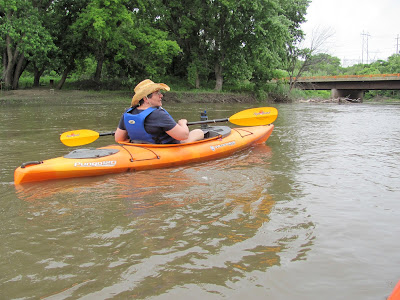I recently became a volunteer with the Outdoor Campus, a South Dakota Department of Game, Fish, and Parks facility located in Sioux Falls, to work especially with paddling classes. My first assignment was to assist with a family paddling event that took place at Family Lake, west on 12th Street near the intersection of 12th Street and the Tea/Ellis Road. The Outdoor Campus has about 16 single kayaks and a couple of tandem kayaks plus several canoes, and these craft were available for families to take out on the lake for nearly two hours of paddling. Paddles and lifejackets were also provided by the Outdoor Campus. This activity is free of any charge!
This blog is designed to highlight the paddling opportunities within South Dakota, mainly within a 50-mile radius of Sioux Falls. While Sioux Falls is far from the adventure of coastal regions, there is a certain satisfaction in utilizing the available waterways to observe weather, water conditions, and the landscape along the shoreline. In addition, there is a wealth of animal life on the waters of small South Dakota lakes, rivers, and creeks, including geese, ducks, pelicans, great blue heron, egrets, hawks, owls, perching birds, deer, raccoons, and beaver. Eagles, fox, and coyote are also sometimes spotted.
The sites described are places where I have kayaked over the past few years, mostly in South Dakota but sometimes including locations in Iowa and Minnesota. One of the best sources of information on the accessibility of small lakes is the South Dakota Atlas and Gazetteer, the large map book of South Dakota. Lakes with a public access are generally identified by a boat symbol marking the location of a launching site on public land.
You will notice the menu of paddling locations on the right side of the blog. Each of the postings is linked to one of the areas, and my intention is to provide a continuing review of the places where I paddle. Perhaps these narratives will help readers select waterways of interest to them. Please feel free to offer a comment regarding any of my postings; I would welcome the dialog.
I also maintain a companion blog that describes hiking opportunities within the Sioux Falls area. You can access that blog at: http://hikingsiouxfalls.blogspot.com
Thursday, June 27, 2013
Paddling in the Sioux Falls Area for People Without a Kayak
I recently became a volunteer with the Outdoor Campus, a South Dakota Department of Game, Fish, and Parks facility located in Sioux Falls, to work especially with paddling classes. My first assignment was to assist with a family paddling event that took place at Family Lake, west on 12th Street near the intersection of 12th Street and the Tea/Ellis Road. The Outdoor Campus has about 16 single kayaks and a couple of tandem kayaks plus several canoes, and these craft were available for families to take out on the lake for nearly two hours of paddling. Paddles and lifejackets were also provided by the Outdoor Campus. This activity is free of any charge!
Wednesday, June 19, 2013
Pease Creek Recreation Area, Geddes SD, June 9-10, 2013
Monday, June 17, 2013
Lake Menno - late spring 2013
A complete set of photographs from this trip to Lake Menno can be found on my Flickr account at the following URL: http://www.flickr.com/photos/jayheath/sets/72157634182609184/
Sunday, June 16, 2013
Big Sioux River: Lien Park (Sioux Falls) to Brandon
This afternoon (Sunday), a fleet of ten kayaks under the leadership of Dave and Mary Finck and Larry Braaten made the cruise from Lien Park on North Cliff Avenue to the northern edge of the Big Sioux Recreation Area on the north side of Brandon – a distance of about nine miles.




















































